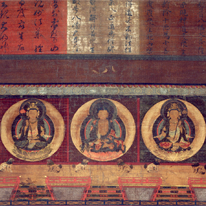Past Exhibitions
- Shinto-Buddhist Syncretic Paintings
- January 2, 2015 - February 8, 2015
During the New Year, the shrines and temples of Kyoto bustle with worshipers making their first visits of the year (hatsumōde). In the past, people would visit community shrines or shrines associated with specific years in the zodiac cycle. In the modern period, however, such practices were replaced by New Year’s visits to famous shrines and temples. Even the word hatsumōde is a modern invention created to accommodate this practice.
Syncretic paintings (suijaku ga) are scenes of shrines or images of deities with connections to both Shinto and Buddhism. Originally, Shinto deities were rarely represented in human form. This practice became popular only under the influence of Buddhism. The Shinto images shown here would have been hung as the icons of worship when parishioners gathered for rituals in temples or shrines.
The Thirty Deities (sanjūbanjin) are a set of Shinto gods (kami), each representing a powerful shrine. These deities were first widely worshipped in the Kamakura period (1185–1333) and were thought to trade off duties with one another in order to protect the nation and its people during each of the thirty days of the month.
Perhaps if you make your New Year’s prayers here, you will reap the benefits of worship at thirty different shrines.












